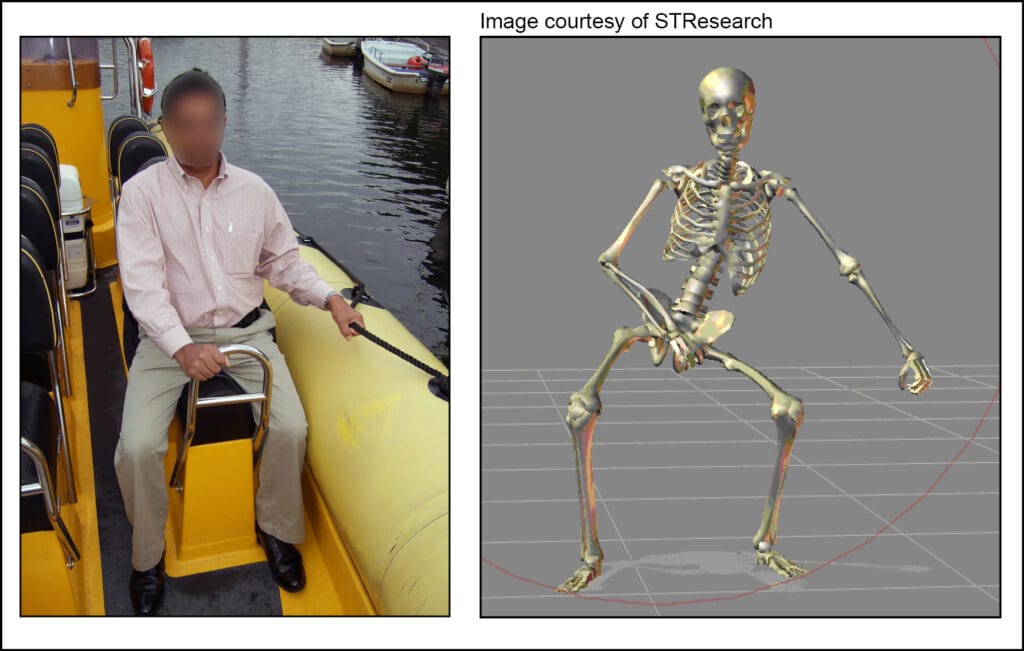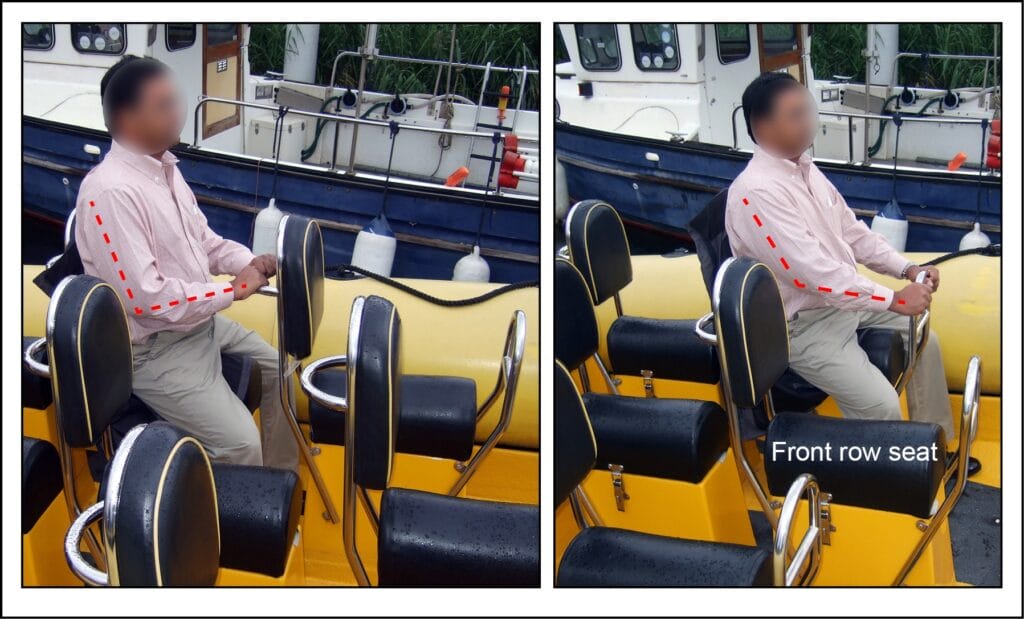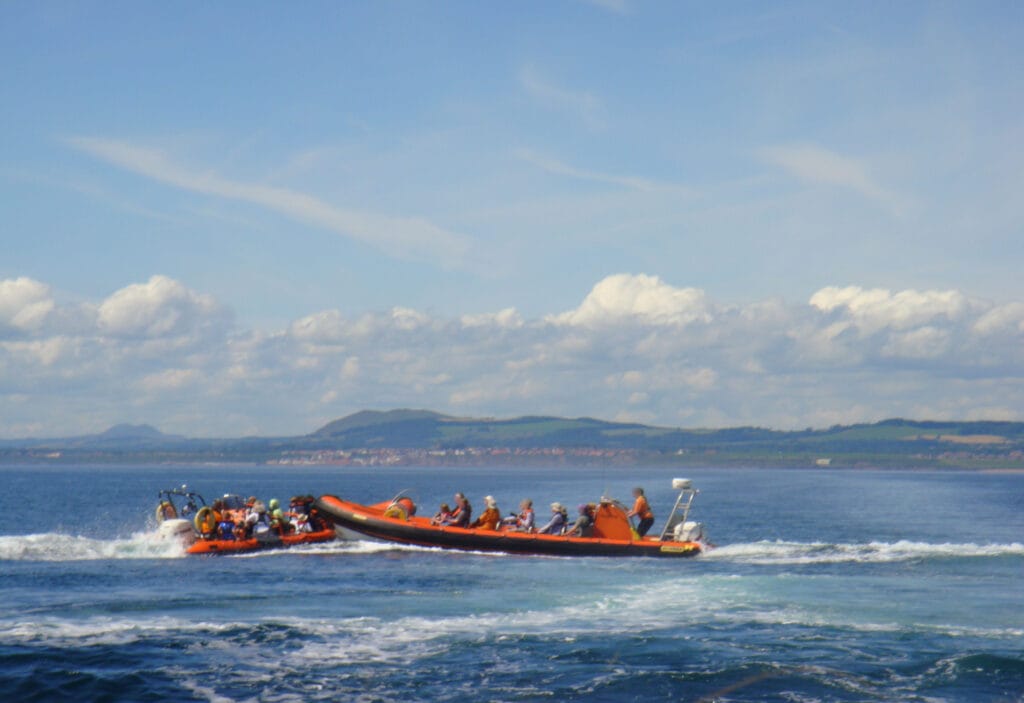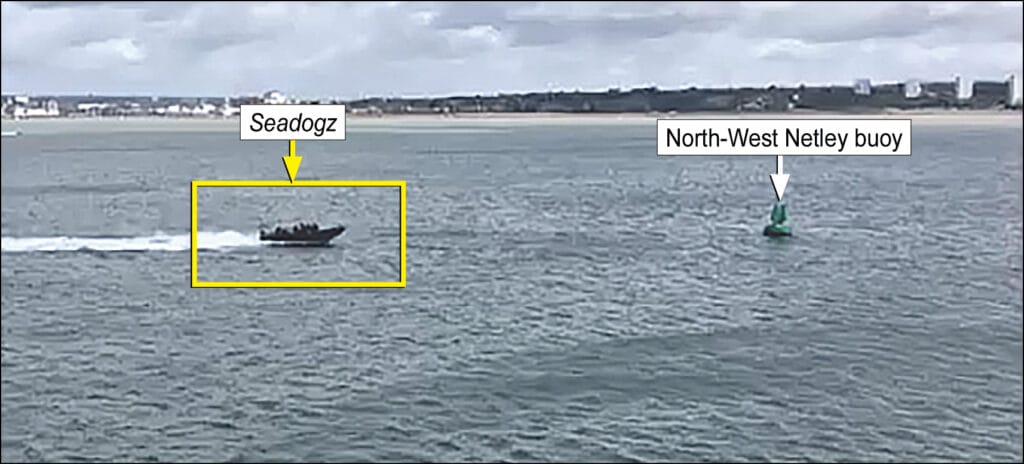
Le marché artisanal doit informer les clients des dangers, selon la MAIB, pour éviter les blessures des passagers

Une mauvaise posture, une assise inadéquate et une multitude d'autres facteurs peuvent entraîner des blessures qui changent la vie des passagers sur les bateaux semi-rigides, car la sécurité des passagers est au cœur des préoccupations en raison des événements récents. Si la réputation du secteur doit survivre à des accidents comme celui de Seadogz , les propriétaires et les exploitants doivent commencer à adopter les meilleures pratiques, à contrôler les risques et à démontrer que leurs voyages sont sûrs, déclare la MAIB.
Lorsque vous essayez de promouvoir l'aspect ludique d'une activité, il peut sembler contreproductif de dire à vos clients que cette activité peut être dangereuse. Cela pourrait expliquer la réticence du secteur des « excursions en bateau pour passagers et expériences » à reconnaître et à prendre des mesures en conséquence des conclusions des enquêtes récentes sur les accidents.
Cependant, tant que les leçons ne seront pas retenues et que des mesures appropriées ne seront pas prises, les passagers continueront de subir des blessures qui changeront leur vie et risquent de mourir, comme le montre le rapport d'enquête de la Marine Accident Investigation Branch (MAIB) sur l'accident du RIB Seadogz . Si ce message semble percutant, c'est qu'il l'est.
Les enquêtes de la MAIB sur la vulnérabilité des passagers
Le MAIB a enquêté sur de nombreux accidents impliquant des semi-rigides, dont beaucoup sont évoqués dans cet article. Si les premières enquêtes se sont concentrées sur les collisions et les échouements habituels, ce n'est qu'à partir de l'enquête sur l'atterrissage brutal du semi-rigide Celtic Pioneer en 2008 que la vulnérabilité des passagers aux blessures est apparue au grand jour.

Ce rapport d’enquête s’appuie sur des recherches universitaires et pratiques récentes pour souligner l’importance d’une bonne assise, d’une bonne posture et de bonnes prises pour aider à atténuer les blessures à la colonne vertébrale. Il a été constaté que la partie particulièrement vulnérable de la colonne vertébrale était la région lombaire inférieure (L1 à L3), qui pouvait souffrir de fractures par compression cunéiforme, mais d’autres lésions de la colonne vertébrale n’étaient pas rares (image reproduite avec l’aimable autorisation de ST Research).
Heureusement, les passagers ayant subi des blessures moins graves sortaient souvent du semi-rigide avec un mal de dos, mais si la douleur persistait, ils consultaient leur médecin quelques jours plus tard, le lien entre le mécanisme de la blessure (le trajet en semi-rigide) et la blessure ayant alors été perdu. Par conséquent, la MAIB n'était au courant que des accidents où les services d'urgence avaient été appelés pour extraire la personne blessée. Cela a donné lieu à une image faussée du taux réel de blessures.
Néanmoins, le nombre d'accidents signalés était encore suffisant pour que la branche mette en garde contre les conséquences d'une mauvaise posture et d'une assise inadéquate (images avec l'aimable autorisation de Celtic Pioneer Report et ST Research).



Malheureusement, les messages n'ont pas été transmis et peu de temps après, une personne se rendant au travail sur la Tamise a subi une blessure très grave au dos lorsque le bateau pneumatique sur lequel elle voyageait a croisé le sillage d'un autre navire à environ 30 nœuds.
Le travailleur était assis sur un casier sans rembourrage ni poignées et avait son sac à dos sur la poitrine (image avec l'aimable autorisation de MAIB).
La combinaison du siège dur et d'une mauvaise posture a entraîné chez la victime des fractures cunéiformes antérieures des première et troisième vertèbres lombaires (L1 et L3). La victime a été équipée d'un corset externe à l'hôpital et est restée en arrêt de travail pendant plus de quatre mois pendant sa convalescence, bien qu'elle ait continué à recevoir des soins de physiothérapie huit mois après l'accident.
En réponse aux recommandations du MAIB, l'industrie a produit deux codes de pratique volontaires pour les opérateurs de bateaux pneumatiques, mais leur adoption initiale a été inégale.
Risques d'impact latéral pour les passagers voyageant sur des semi-rigides

La collision entre l'Osprey et l'Osprey II (image reproduite avec l'aimable autorisation de Teresa Wong-Hui), qui a laissé un passager avec des blessures qui ont changé sa vie, a mis en évidence la vulnérabilité des passagers des petites embarcations aux blessures par impact latéral.
Les accidents impliquant de petits bateaux de course ont montré avec quelle facilité un bateau heurtant l'autre de côté pouvait passer par-dessus, et que les passagers du bateau receveur n'avaient que peu ou pas de protection. Les bateaux pneumatiques étaient particulièrement vulnérables car la forme des tubes aidait à soulever la proue du bateau en collision de sorte qu'elle traversait la zone des sièges, et tout passager assis sur les tubes pouvait encaisser toute la force de l'impact. Non seulement il était impossible de maintenir une bonne posture en étant assis sur un tube, mais les risques supplémentaires liés à un impact latéral étaient considérés comme trop élevés et le MAIB a recommandé que lorsque la Maritime and Coastguard Agency (MCA) mettrait à jour les codes des petits bateaux commerciaux, elle inclurait une exigence selon laquelle chaque passager d'un bateau pneumatique transportant des passagers exploité commercialement dispose d'un siège adapté.
L'accident des bateaux pneumatiques Osprey a également mis en évidence les dangers liés à la proximité d'embarcations rapides ou à grande vitesse, où, à moins que leurs manœuvres ne soient bien coordonnées, le risque de collision peut être élevé . Bien que les deux bateaux pneumatiques se croisent généralement lors d'un virage à grande vitesse programmé, le jour de l'accident, leurs positions de départ étaient inversées. Alors que les bateaux pneumatiques se rapprochaient l'un de l'autre, les capitaines ne savaient pas s'ils devaient se croiser « normalement » ou suivre les COLREG et se mettre chacun à tribord. Bien que les deux capitaines aient réduit leur vitesse, les bateaux pneumatiques sont entrés en collision, écrasant un passager contre la console. Si le risque de collision pendant le virage avait été envisagé avant le voyage, des mesures d'atténuation des risques auraient pu être prévues.
Risques d'impact frontal pour les passagers des semi-rigides
Le 22 août 2020, le semi-rigide commercial Seadogz a heurté une bouée de navigation à grande vitesse dans les eaux de Southampton (image reproduite avec l'aimable autorisation de H Tuck). Le skipper et les 11 passagers ont été blessés par impact. Deux passagers ont été projetés à l'eau et Emily Lewis, 15 ans, qui était assise au milieu de la banquette, a subi des blessures mortelles.

L'enquête de la MAIB a conclu que le capitaine n'avait pas vu la bouée suffisamment à temps pour l'éviter car il avait perdu conscience de sa position, probablement en raison de la charge de travail mentale élevée que représentait le pilotage du RIB seul et à grande vitesse.
De plus, les sièges et les poignées du semi-rigide offraient peu de protection aux passagers lors d'une décélération rapide, les procédures de gestion de la sécurité de l'opérateur étaient superficielles et génériques, et la réglementation actuelle pour de telles opérations devait être mise à jour.
D'autres problèmes de sécurité ont également été identifiés. Deux passagers ont été éjectés dans l'eau, l'un d'eux a commencé à paniquer lorsque son gilet de sauvetage s'est gonflé car il n'était pas correctement ajusté. Depuis le poste de barre, l'inclinaison de la proue du semi-rigide et la tête des passagers limitaient la visibilité vers l'avant du skipper.>
Le RIB Ride n'est pas conforme aux « bonnes pratiques »
Le plus inquiétant est que le déroulement du voyage n'a pas été à la hauteur des « bonnes pratiques » à bien des égards. Les virages serrés en huit effectués à grande vitesse introduisaient un risque d'accrochage ; le semi-rigide sautait par-dessus les sillages et les passages fréquents à proximité des grandes bouées de navigation rendaient les passagers insensibles au risque de collision.
Lorsque le Seadogz se dirigeait directement vers la bouée latérale de North-West Netley, il est probable que la plupart des passagers s'attendaient à ce que le semi-rigide fasse demi-tour à la dernière minute. Lorsque cela ne s'est pas produit, il était trop tard pour avertir le skipper de la collision imminente.
En réponse à l'accident, la Royal Yachting Association (RYA) a commencé à mettre à jour le code de pratique volontaire sur la sécurité des passagers à bord des bateaux commerciaux à grande vitesse et des promenades en bateau, et la MAIB a, une fois de plus, formulé un certain nombre de recommandations.
Le rapport d'enquête recommandait que la MCA mette en place des directives actualisées (le Code des navires de sport et de plaisance) dès que possible. Cependant, notant les risques pour les passagers liés aux impacts verticaux et latéraux déjà identifiés lors d'enquêtes précédentes, la MAIB a également recommandé que la MCA effectue une évaluation anthropométrique complète des risques pour les passagers voyageant dans de petites embarcations à grande vitesse, dont les résultats devraient être reflétés dans le nouveau code dès que possible. Il a également été recommandé aux associations portuaires de fournir des conseils aux autorités portuaires sur la manière dont elles devraient superviser les activités des petites embarcations commerciales opérant dans les zones portuaires.
Les opérateurs doivent comprendre et appliquer les leçons apprises en matière de sécurité des passagers sur les bateaux semi-rigides
Les premiers retours d'expérience montrent que de nombreux opérateurs semblent se distancier de l'accident de Seadogz en affirmant que les leçons ne s'appliquent pas à leur activité : les safaris en mer et les excursions d'observation de la faune sauvage ne sont pas des attractions à grande vitesse et à sensations fortes, « donc nous pouvons continuer comme d'habitude ». Peut-être a-t-on trop mis l'accent sur la « grande vitesse », mais la réalité est que les passagers des bateaux semi-rigides peuvent subir des blessures horribles même à faible vitesse. La collision entre Osprey et Osprey II s'est produite à une vitesse relativement lente, mais ces gros bateaux semi-rigides pesaient chacun plusieurs tonnes, de sorte que la force d'écrasement était importante. Et, l'été dernier, un passager d'un bateau semi-rigide de safari en mer a subi des blessures à la colonne vertébrale qui ont changé sa vie lorsque le bateau semi-rigide, qui se déplaçait à une vitesse assez lente, est tombé d'une vague dans un creux profond.
Le temps nous dira si le public évitera les promenades en bateau pneumatique à cause de l’accident de Seadogz , mais l’industrie peut être certaine que ceux qui font des voyages ne s’attendent pas à passer le reste de leur vie en fauteuil roulant à cause d’une blessure subie pendant le voyage.
Un marché solide pour les promenades en bateau pneumatique si les propriétaires « s'approprient » les meilleures pratiques
Les promenades en bateau pneumatique sont accessibles et amusantes lorsqu'elles sont bien organisées et il existe un marché solide pour elles. Cependant, alors que le Code des navires de sport et de plaisance est en cours d'élaboration et que le Code de bonnes pratiques volontaire sur la sécurité des passagers à bord des navires commerciaux à grande vitesse et des promenades à sensations est en cours de mise à jour, il n'est pas nécessaire d'attendre ces derniers pour apporter des améliorations. Si la réputation du secteur doit survivre à des accidents comme celui de Seadogz , les propriétaires et les exploitants doivent commencer à adopter les meilleures pratiques, à contrôler les risques et à démontrer que leurs sorties sont sûres.
Procédures d'exploitation axées sur la sécurité des passagers pour les bateaux semi-rigides
Les bonnes pratiques sont enseignées pendant la formation de la RYA, et de nombreuses directives sont disponibles dans le Code des embarcations commerciales à grande vitesse et des promenades d'expérience et sur le site Web de la RYA. Cependant, il convient de rappeler quelques points clés.
Les opérateurs doivent être clairs sur le type de voyages qu’ils proposent, évaluer les risques et s’assurer que des mesures d’atténuation appropriées sont en place. Si les mesures d’atténuation ne peuvent pas être mises en œuvre, le voyage ne doit pas être proposé.
Une attention particulière doit être portée aux retours d'expérience. Si quelqu'un a été blessé dans le passé, le parcours/itinéraire doit être adapté pour éviter que cela ne se reproduise.
Briefing. Tous les barreurs doivent être informés de ce qu'ils doivent faire et de ce qui est interdit. Si, par exemple, le siège du bateau ne permet pas d'atténuer les chocs, des limites strictes de vitesse et d'état de la mer doivent être fixées et respectées. Si le voyage implique des manœuvres à grande vitesse, un deuxième membre d'équipage est-il nécessaire pour aider à surveiller la sécurité des passagers pendant que le skipper se concentre sur la barre ?
Briefing avant le départ. Un bon briefing avant le départ comporte de nombreuses étapes, outre le fait d'expliquer aux passagers ce qu'ils vont vivre. Le fonctionnement des gilets de sauvetage doit être expliqué et leur ajustement doit être vérifié ; les passagers doivent savoir comment s'asseoir correctement, se caler et se tenir ; chaque passager doit savoir comment s'asseoir correctement, comment s'accrocher et comment s'accrocher. doivent être placés dans un siège adapté à leurs besoins et des contrôles doivent être effectués pour s'assurer que leurs pieds peuvent prendre fermement appui sur le sol, que leur dos peut reposer sur le support dorsal et qu'ils peuvent saisir correctement les poignées.
Signalisation. Les moyens de signaler une inquiétude ou un problème doivent être à la fois compris et réalisables. Il est peu probable que les passagers lèvent la main s'ils s'accrochent à leur vie. Tout cela prend du temps, il faut donc prévoir le temps nécessaire ou faire appel à d'autres membres du personnel. Le fait de suivre les consignes tout en marchant vers le bateau ou d'enfiler des gilets de sauvetage en cours de route peut faire gagner du temps, mais ne sauvera pas des vies.
Conduite du voyage. Le voyage doit toujours être organisé en fonction de l'offre proposée. Si les passagers ont réservé une excursion en safari en mer, ils ne s'attendent peut-être pas à vivre une aventure à sensations fortes impliquant des virages serrés à grande vitesse ou des sauts de vagues et de sillage. Même les passagers en quête de sensations fortes peuvent trouver excitant de manœuvrer à 25 ou 30 nœuds, alors naviguer à 40 ou 50 nœuds peut se transformer en une expérience terrifiante.
Il est important de se rappeler que les skippers peuvent facilement se sentir isolés de l'expérience proposée. Si le bateau semi-rigide est doté d'un poste de barre arrière, les mouvements ressentis par l'équipage seront beaucoup plus doux que ceux ressentis par les passagers près de la proue. Le skipper regarde devant lui et barre pour pouvoir anticiper les mouvements du bateau, il sait se préparer et, bien sûr, il a déjà fait ce voyage plusieurs fois auparavant. Une promenade en bateau semi-rigide avec passagers n'est pas le moment de commencer à explorer les limites de fonctionnement de son bateau ; quelle que soit l'expérience proposée, la principale préoccupation du skipper doit être de ramener ses passagers à terre sains et saufs.
Cet article a été publié pour la première fois dans Powerboat & RIB Magazine .
Le marché des petites embarcations doit informer les clients des dangers, déclare la MAIB, pour éviter les blessures des passagers est apparu en premier sur Marine Industry News .
